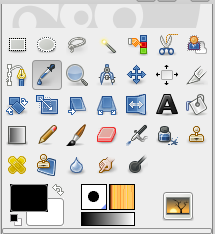

Note that other formats, like tiff or png do not retain internal data structures needed by the exporter script, so do not use anything other than xcf. You can save the image as Gimp xcf file and continue editing and export it later. You can use the GIMP color picker tool to select the colors you want. If you have rendered the font using 2 bits per pixel, just reuse the colors from the pixels. All other values are treated as "background" pixels by the exporter.

If you have rendered the font using 1 bit per pixel, pixels that are black (0, 0, 0) and fully opaque (255) are interpreted as "set" pixels. At this point you can start editing this layer. Any pixel of the glyph that falls on these blue lines belongs to its glyph, but pixels that lie to the right or below these blue lines are not considered to be a part of the glyph.įont data is in the Glyphs layer. The background layer is there just for reference.īlue lines indicate right and bottom edges of each glyph. The image is going to contain two layers: Glyphs and Background. Make sure all the characters you need are in the "Characters" text box Ĭlick OK to generate your image. Roboto 24 has glyphs 31 pixel tall):Ĭhoose between 1 bit per pixel (no antialiasing - jagged edges, font fits in fewer bytes) and 2 bits per pixel (smoother looking symbols, font arrays are larger)

Select the font to render, select font size (note that your glyphs are normally taller than that, e.g. Go to File -> Create -> Render font as bitmap. This is due to the way flatpak keeps installed applications sandboxed. if you have installed GIMP using flatpak (this is the official way to do it on Linux at the moment), you're probably better off adding a new folder to the list of GIMP plug-in folders in Edit > Preferences > Folders > Plug-ins and copying the files into that folder.on Windows, placing the files in C:\Users\\AppData\Roaming\GIMP\2.10 does not work for whatever reason, but placing them in C:\Program Files\GIMP 2\lib\gimp\2.0\plug-ins works just fine (replace C: with the drive letter where you have GIMP installed).(Skip if you're using Windows) Change file permissions by adding executable bit: chmod +x gimp_bfont_render.py, chmod +x gimp_bfont_export.py To find out its location, run Gimp and go to Edit > Preferences > Folders > Plug-ins (but pay attention to the peculiarities mentioned below) InstallationĬopy gimp_bfont_render.py and gimp_bfont_export.py to your Gimp plugins folder. bfont files), check out bfont_user_example folder.
#Gimp font picker how to
The plugins have been tested on Windows and Linux with GIMP 2.10.22, which is the latest stable version of GIMP as of this writing.įor an example of how to use the generated C arrays (in. The format of these arrays is described in the comments in. This is a set of two plug-ins for Gimp for (a) rendering system fonts as bitmapped images and (b) exporting said images to specific text files (.bfont files) containing C arrays, that can be used to render text. Render fonts to bitmap images in Gimp and export them to C arrays.


 0 kommentar(er)
0 kommentar(er)
